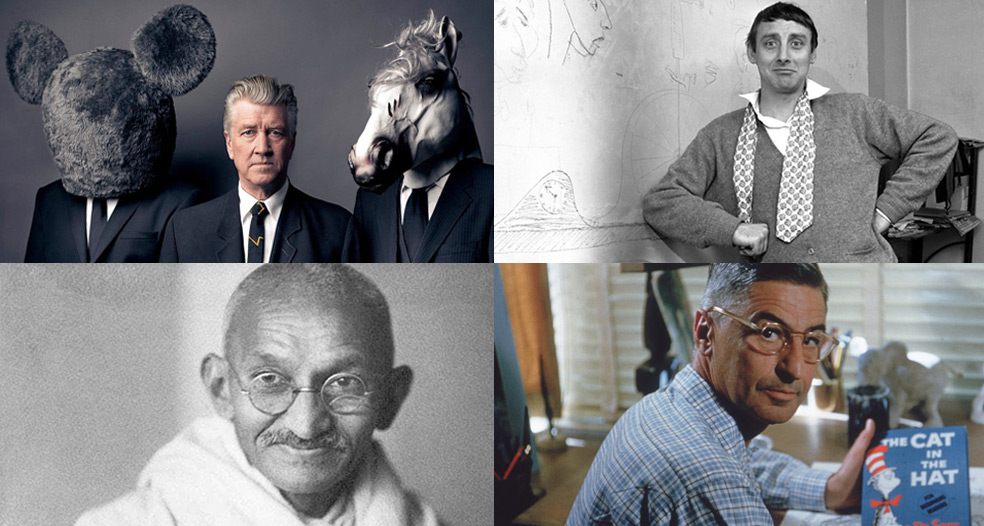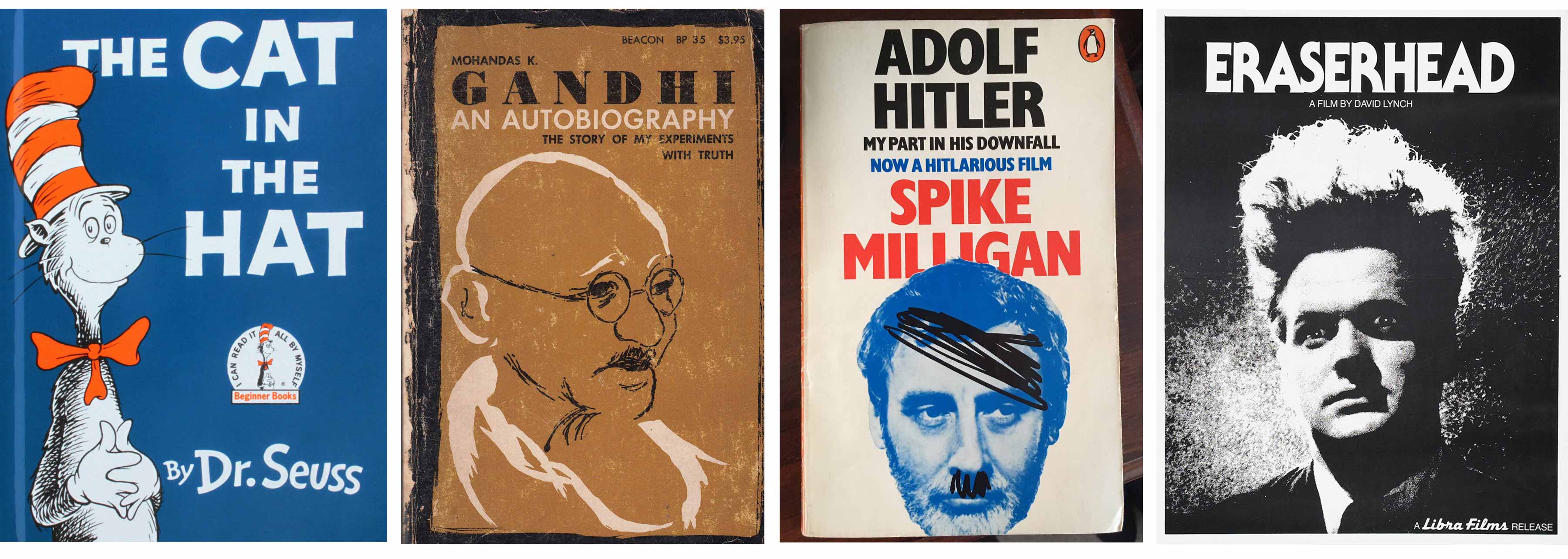Rules are great. Let’s break ’em.

Next time someone tells you the headline you’re writing HAS TO be 9 words or less, or that it HAS TO go above the picture, tell them that there are no HAS TO’s when it comes to creativity.
If they need proof, tell them to read this.
Here’s to the mavericks, the rule breakers; those who put their unique creative stamp on the world and left their mark in my heart.
Without rules there would be chaos, but if no one ever broke them, then where would we be?
Vanilla. Magnolia. Salt-free Rice Cakes.
Rule breakers give the world its pizzazz and open up new possibilities.
Without these rule breakers, I wouldn’t be the person I am today, so here’s a mini tribute to four of them:
Spike Milligan: Author, comedian, actor, playwrite, poet and titillator of the teenage me.
Born in 1918 in India to an Irish Father and English Mother, Spike Milligan was perhaps best known as one beautifully bonkers fourth of the Goons. Along with Harry Secombe, Peter Sellers and Michael Bentine, he introduced a generation who had grown up with Ealing comedies and Carry On films to a new style of comedy and paved the way for the likes of Monty Python and Vic & Bob.
The books he wrote that chronicled his wartime experiences as ‘Gunner Milligan, 954024’, found creativity and humour where many would have only seen darkness and desperation. I read and re-read Adolf Hitler: My Part in His Downfall and “Rommel?” “Gunner Who?”: A Confrontation in the Desert, with absolute glee. I fell hook line and sinker for his use of language – a silliness that completely captivated me.
Sadly, Spike Milligan lived with a ton of depression on his shoulders, but for me he was a first class hero. Although his mental condition often made him spiral down into a whirlpool of grey, he still managed to bring joy, beauty and mischief into the world.
Favourite quote: “I’m not afraid of dying I just don’t want to be there when it happens.”
David Lynch: Painter, film maker, writer, musician, photographer and weaver of dark tales.
If you’ve only seen Twin Peaks, you probably think you’ve seen the oddest nuggets of David Lynch’s imagination. If so, get hold of a copy of Eraserhead and strap yourself in. Here’s a trailer to test the water with.
I remember the first time I saw Eraserhead, I was completely blown away. Never mind the woman with a head like a cauliflower that lives behind a radiator, or the roast chicken that spasms and spews blood. There’s one scene where the camera pans around a group of people, like a spinning bottle observing a circle of oddbods and misfits. It completes its circle so slowly that it builds the most incredible tension. I’d never seen anything like it before. After the first minute, you find yourself screaming inside “please make it end”, but at the same time it’s like some kind of excruciating visual poetry.
In his book, Catching the Big Fish, Lynch describes Eraserhead as his “most spiritual movie,” but for me it taps into a dangerous and unpredictable style of storytelling. Like Luis Buñuel and Salvador Dalí’s short film, Un Chien Andalou, few dare to go there.
Favourite quote: “The ideas dictate everything, you have to be true to that or you’re dead.”

Mahatma Gandhi: Philosopher, spiritual leader, activist and rebel.
Mohandas Karamchand Gandhi was born in 1869 and was assassinated in 1948. For many of his followers he was Bapu, or Father, but most of us know him as Mahatma or ‘Great Soul’.
At a time when one half of India was trying to kill the other half, Gandhi stood out as a guiding light. He was principled, single-minded and driven by a belief that mankind could live in peace. It would be impossible to exaggerate the influence that he had on a whole nation (and on me).
His autobiography, The Story of My Experiments with Truth, is Gandhi laid bare. Here is a man who was truly on a mission to know himself and to bring about justice for millions of people.
In one inspirational passage, Gandhi says, “If I believe I cannot do something, it makes me incapable of doing it. But when I believe I can, then I acquire the ability to do it even If I didn’t have it in the beginning.” This remarkable book showed me in no uncertain terms what self belief and the spirit of sacrifice can achieve.
Favourite quote: “First they ignore you, then they laugh at you, then they fight you, then you win.”
Dr. Seuss: Author, cartoonist, artist, poet, animator, publisher and children’s mesmerist.
I can still visualise the cover of the copy of ‘Cat in the Hat’, that I had as a nipper. The pictures were amazing, but the words were on another level. Compared to Squirrel Nutkin or The Famous Five, The Cat in the Hat was pretty out there, but to an early years reader like me it was pure, unadulterated joy on a page.
In 1954, Life magazine published a report that stated that children weren’t learning to read because kids’ books were boring. William Spaulding, the director of the education division of publishers, Houghton Mifflin, compiled a list of words that he felt were important for young children to learn. Spaulding challenged Dr. Seuss (real name Theodor Seuss Geisel) to “bring back a book children can’t put down”, using 250 of the words on the list. Nine months later, The Cat in the Hat was born. Here’s a snippet:
‘now look what you did!’
said the fish to the cat.
‘now look at this house!
look at this! look at that!
you sank our toy ship,
sank it deep in the cake.
you shook up our house
and you bent our new rake.
you SHOULD NOT be here
when our mother is not.
you get out of this house!’
said the fish in the pot.
Statistics vary, but according to most sources, by the time he died in 1991, Dr. Seuss had already sold well over 500 million copies of his children’s books. To put that into perspective, that’s more than Enid Blyton, JK Rowling or Roald Dahl. And more than 60 years since first being published, The Cat in the Hat still outsells most children’s books.
Favourite quote: “I like nonsense; it wakes up the brain cells.”
Although these heroes of mine all live(d) and work(ed) in different spheres, they have many qualities and values in common – all worth clinging on to.
– Self confidence
– A sense of humour
– A belief that anything is possible
– Creativity
– Determination
– Guts.
What’s that I hear you cry, “What about Christo, Florence Nightingale, Jimi Hendrix, Spike Lee, Edward Lear, Picasso, Aphex Twin, Walt Disney…” well maybe that’s another blog post for the future.
Enjoyed this? These articles might be worth a dip:
Where do creative ideas come from?
What I learnt in 2017
Jonathan Wilcock (that’s me) is a Senior Freelance Copywriter.
You can drop me a line here, or email jonathan@sowhatif.co.uk